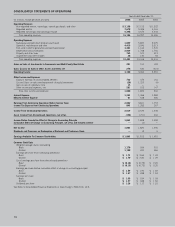Duke Energy 2006 Annual Report Download - page 30
Download and view the complete annual report
Please find page 30 of the 2006 Duke Energy annual report below. You can navigate through the pages in the report by either clicking on the pages listed below, or by using the keyword search tool below to find specific information within the annual report.28
UTILITY OF THE FUTURE
As the electric grid goes digital, we can meet our customers’
growing appetite for better energy-efficiency information,
programs and technologies; for plug-in electric hybrid
vehicles; for distributed generation, which is power
produced from smaller and more localized generating
units, and for more base load power generated from
renewable sources.
A NEW BUSINESS MODEL
The utility of the future will focus on generating, delivering
and using energy more efficiently. The business model
is based on capturing information and relaying it to our
customers, who can use it to make better energy decisions.
This model will also help us balance supply and demand,
and respond faster to service interruptions.
For example, new “smart meters” will tell customers
exactly how much electricity they are using at any given
time. These meters will also tell us when, how and in what
quantities customers are using power. This will allow us
to provide exactly what they need along the most efficient
distribution circuits. In essence, the meter becomes an
interactive information gateway, not just a passive billing
device. The usage data we compile will also help us
make better long-term decisions about the need for
new transmission and distribution systems.
The utility of the future will make us all more efficient.
Already on the drawing board are designs for new trans-
formers that will convert voltages with greater efficiency
for homes and businesses. New electric wire alloys
will let us transmit power with less resistance. All of
the components of the energy delivery system will be
linked through real time communication over wires
already in place in every home and business.
We have several other initiatives already under way,
including our broadband-over-power-line (BPL) pilot
programs in Charlotte, N.C., and Cincinnati, Ohio. Our
energy monitoring and metering solution at the EPA
labs and computing center at Research Triangle Park
in North Carolina (see pages 23-25) can be the
platform for the expansion of this technology to
residential, commercial and industrial customers.
FORMING ALLIANCES
Our imaginative initiatives aren’t limited to smart
metering and exploring new technologies. To promote
energy efficiency, we are forming new collaboratives with
our stakeholders, including alliances with retailers and
suppliers, to inform customers — both small and large —
of readily available tools and technologies to reduce
energy use.
Duke Energy is well positioned to solve energy problems
for our customers. We understand energy use, we have
a low cost of capital, and we are working through alliances
and with third parties to implement the best solutions
for customers.
The long-term goal for the utility of the future is simple:
to provide greater reliability with less environmental impact
at a lower cost to our customers. New programs delivered
through new channels will make it happen.
28
























